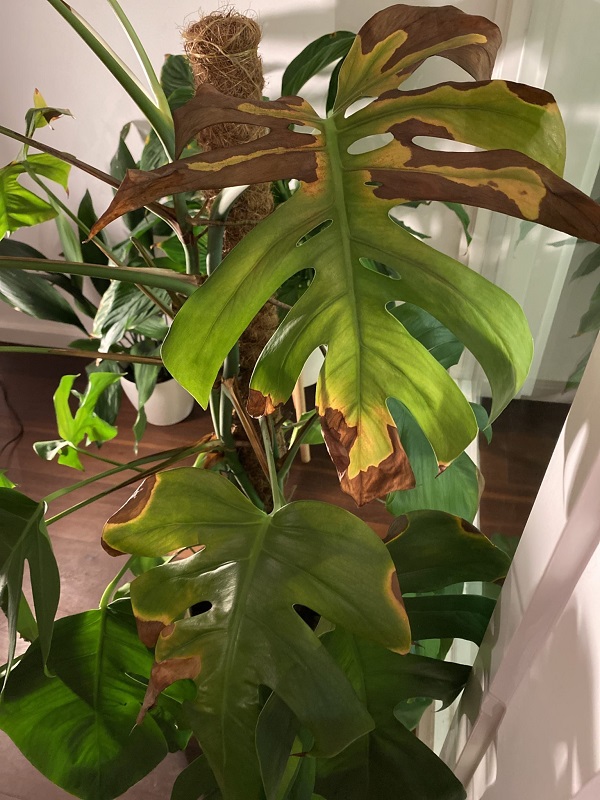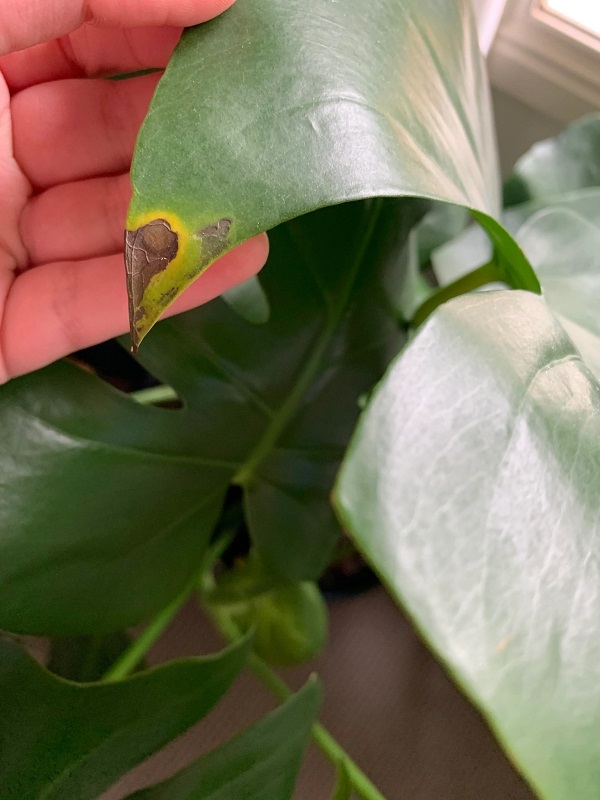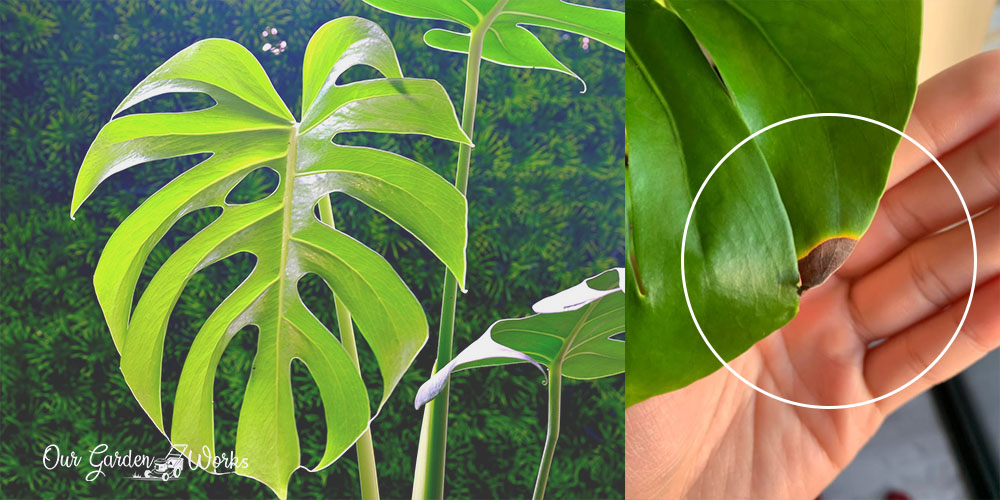As the pandemic hit its peak in 2020, so does the rise of monstera as a favorite houseplant. Though it’s easy to grow, monstera leaves turning brown became a major concern for first-time plant parents. The common culprit usually lies in watering and sunlight exposure issues.
The unique leaves of Monstera are its crowning glory. So, any unpleasing patches on the leaves or leaf split issues can alter their lush image into a sick-looking one.
Discover why your monstera leaves are turning brown and what you can do about it to prevent the other leaves from experiencing the same fate.
Monstera leaves turning brown: Top 7 possible causes
Before checking out why are monstera leaves turning brown, it’s crucial that you know what is the ideal growing environment for these tropical plants.

Doing so will help you easily figure out the root cause of the problem without diving into the rabbit hole of horticultural research.
Monstera is a member of the plant family Araceae which includes the other popular houseplant like philodendrons. They grow and thrive in a warm and humid environment.
As a hemiepiphyte, monstera develops aerial and soil roots which allows them to grow in soil and on trees.
Unlike other low-maintenance plants, monstera loves moderation when it comes to watering and sunlight exposure.
The secret to their shiny and beautiful leaves also lies in humidity, since they also absorb water through their gigantic leaves and aerial roots.
If you think you knew all of the monstera fun facts above, you might be wondering where it all went wrong that led to some leaves turning brown.
Well, there’s no simple answer since there are 7 possible causes that start off from the most common problem – overwatering.
#1 Watering issues
Watering plants is one of the puzzling parts of plant care. Usually, homeowners master the proper watering of monstera by learning the hard and expensive way.
There are two types of browning that will help immediately identify the problem:
- Dark brown spots/patches: Overwatering.
- Light brown and papery edges: Underwatering.
Monstera loves damp soil and usually thrives in weekly light watering. However, when the temperature changes indoors, the frequency and amount of watering should also change.
The rule of thumb is to increase watering when the weather is warmer and decrease watering during the colder months.
The transpiration and moisture expenditure of the plant increases when it’s warm or hot to cool down. When the roots fail to absorb moisture from the soil, the leaves will heat up until they dry out leading to papery thin brown edges.
On the other hand, when it’s cooler, the plant won’t need too much moisture and will have a slower moisture absorption process.
So, if you continue to water during the colder months, the soil will be too soggy for the roots, leading to root rot.
Root rot disables the plant’s feeding system which leads to secondhand nutrient deficiency with symptoms such as yellowing and browning of leaves.

How to treat overwatered monstera plants
Several factors contribute to overwatering issues not only in monstera but also in all kinds of plants. These include:
- Soil drainage.
- Pot drainage.
- Pot size.
- Watering amount and frequency.
- Climate or indoor temperatures.
You might be watering your monstera with an adequate amount but if the soil is too clogged, compacted, or contains too many water-retaining materials, you’ll still end up with rotten roots.
The pot can also be too big for the plant or has no or blocked drainage holes. Here’s what you should do if you suspect that your monstera is overwatered:
(1) Inspect the soil if it drains properly. Check if the water can manage to flow to the drainage holes. You should also check if there are holes in the pot.
To improve soil drainage, you may add draining materials, such as:
- Sand.
- Bark chips.
- Compost.
(2) The pot should also be in a perfect size for your monstera. If the pot is too big, it will retain too much water than the roots can ever absorb.
The rim of the pot should have a 2 to 3-inch radius from the stem and the depth should not be deep.
(3) Overwatered monstera plants will need a few days to dry out on their own. Avoid watering them for a couple of days up to a week to allow the water to drain out properly. Let the first two inches of the topsoil dry out before watering it again.
(4) Also, observe the climate before watering. If the temperature is around 65°F, you may decrease the watering but when the temperature is around 80°F to 85°F you may increase the watering to compensate for the heat.
How to deal with root rot in monstera
When your monstera has developed root rot in its waterlogged roots, you need to remove the infected parts to prevent the spread of the infection. Here’s how:
- Remove the plant from the pot and separate the soil from the roots. The viable roots should be firm and not mushy while the rotten ones are too soft when touched.
- Using a pruning shear or scissors cut off the mushy and rotten roots.
- Re-pot the newly trimmed monstera and delay watering until it develops new growth.
- You may also cut off the brown leaves to help your monstera in preserving its energy and restore its health.
#2 Sun damage
Monstera only requires bright indirect light. It is one of the reasons why they are the best houseplants since you can place them anywhere in the house as long as they get a glimpse of the sunlight.
If they are mistakenly placed in direct sunlight, they will suffer from dehydration that manifests as brown leaf edges that have a papery texture.
How to treat monstera leaves turning brown due to sun damage
Sadly, you can no longer nurse the scorched monstera leaves back to life.
Here are some of the steps that you can do to help ease the heat stress off your monstera:
- Place the plant in partial shade and ensure that it gets enough water to compensate to the stress it endured.
- Trim the damaged leaves and keep them in an area where it gets the optimal growing conditions away from cold drafts and intense heat.
- Delay fertilization until your monstera recuperates and develops new growth. Feeding plants when they are under stress will only stress them further and do more harm than good.
#3 Low humidity and temperature stress
Monstera may require moderate watering and sun exposure but it needs a humid environment to thrive.
When it gets cold, the indoor humidity will drop which causes stress to monstera, resulting in browning and droopy leaves.
Monstera needs around 60% to 80% humidity levels to thrive. In its natural habitat, monstera is tucked and crawling under the canopies of trees in the rain and tropical forests.
So, replicating that kind of environment indoors will keep the leaves lush, green, and perky.
How to adjust indoor humidity to treat browning monstera leaves
Most people think that buying a humidifier is the easiest way to adjust indoor humidity. However, these steps also have the same effects:
- Adding a pebble tray near the pot.
- Place other houseplants next to the monstera.
- Place the recovering monstera in the bathroom with bright indirect light.
- Increase indoor temperatures.
#4 Fertilizer burns
Monstera is not a heavy feeder. They only need fertilizers once or twice a month.
However, in some cases, slow-release fertilizers fail to dissolve completely and leave too many fertilizer salts in the soil. This will then lead to a strong concentration of salts which can cause fertilizer burns on the roots.
How to treat overfertilized monstera plants
If you mistakenly applied too much fertilizer, you’ll need to leach the excess salts in the soil. You can do this through the following steps:
- Place the pot under running water.
- Let the water flow through the soil to dissolve the fertilizer salts.
- Allow the soil to dry out and delay fertilizing your monstera for a while.
- When feeding better opt for granular or liquid fertilizers since they contain fewer salts compared to slow-release fertilizers.
#5 Poor water quality
Most gardeners use tap water for hydrating plants. However, certain cities and states have an increased fluoride content on their community water system that can cause an adverse reaction on houseplants like monstera and spider plants. They end up having leaves with brown tips, which is often mistaken as sun damage.
Excessive fluoride in tap water accumulates in the soil and causes chemical burns on the roots.
So, most Monstera growers use filtered water for better leaf growth and vigor. However, tap water may also work as long as it is treated first.
How to remove excess mineral salts in tap water
You don’t need to be fancy when taking care of monstera, especially with water. All you can do is treat the tap water using the following steps:
- Fill in a tub of tap water.
- Let it sit overnight. The excess chemicals and minerals in the water will evaporate at night, which will revert the water back to its purest form.
- On the next day, use the treated water accordingly.
#6 Transplant shock
All plants experience transplant shock at some point. The younger the plant, the easier and faster for them to recover on a new pot.
Young monstera will usually have droopy leaves due to transplant shock for 2 to 3 days. However, mature monstera tends to suffer the risks, such as:
- Stunted growth.
- Droopy leaves.
- Browning and yellowing leaves.
The mature monstera that experiences severe transplant shock will require optimal growing conditions to survive.
Sadly, there’s no cure to transplant shock but patience and extended care through continuous plant maintenance until the plant regains its health. Let your monstera rest and take its time to recover.
#7 Fungal disease
Though monstera plants rarely cause headaches to growers, they are not immune to fungal diseases that damage the leaves.

Monstera leaves turning brown, yellow, and sickly are among the early symptoms and could get worse when left untreated.
Here are some of the common fungal diseases and the damage they cause in monstera species:
(1) Eyespot disease (Spilocaea Oleagina) or Peacock eye: If the monstera leaves are turning brown with yellow streaks surrounding the spots, it is possible that you’re dealing with eye spot disease.
It is a fungal infection wherein the spot gets darker at the center and affects the stems and the leaves, even the newly unfurled leaves.
(2) Anthracnose: Unlike eyespot disease, anthracnose attacks monstera when they are starting to develop their splitting leaves.
The pathogens of this disease take advantage of the open wounds or tender edges of leaves to infiltrate the plant.
The early signs of anthracnose are the yellowing of the leaves until they turn brown and overall plant health decline.
Anthracnose is treatable as long as you get rid of the infected parts and it gets the treatment it needs before all of the leaves are damaged.
(3) Botrytis: This fungal disease is also notorious for causing brown and black spots in monstera species. It is treatable and does not pose too much risk to the health of monstera if treated early.
Treatment of monstera fungal diseases and preventive measures
Bacterial and fungal infection requires immediate attention since they can spread like wildfire on your houseplants and cause expensive damage.
Here’s what you should do if you suspect that your monstera has a fungal disease:
(1) Remove the infected plant parts like brown leaves, stems, or roots. Those infected parts become the reproduction ground of pathogens and produce spores that contaminate your garden tools and spread the disease to other plants.
(2) Use organic fungicide and spray it on your monstera. Neem oil, in particular, is a 3-in-1 plant treatment since it can serve as an insecticide, fungicide, and miticide.
All you need to do is dilute it with water and wipe it on the leaves to remove the microscopic spores on your plants.
(3) Make sure to sanitize all your tools by wiping them with alcohol or soapy water.
(4) Also, ensure that all infected parts are placed in a plastic bag and thrown in the trash. Do not throw the infected parts of monstera in compost to avoid spreading the fungal diseases to other plants.
(5) Lastly, it’s best to add preventive fungicide sprays to your routine to keep your plants safe from potential diseases in the long run.
Final Thoughts
We hope that this post helped you narrow down the possible cause of monstera leaves turning brown.
The good thing about Monstera is they are tough when it comes to handling plant stress, especially those established ones. They may suffer a few symptoms and sacrifice a few leaves, stems, and roots. However, once they are treated, the leaves can go back to their glorious lush green color and vigor.
Let us know in the comments which plant stress tainted your monstera’s beautiful leaves and how you deal with it.
Also, please don’t forget to share this post with your friends and help them cut the chase and find the problem easily.
